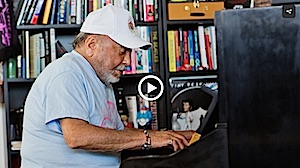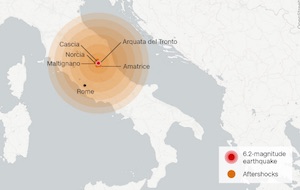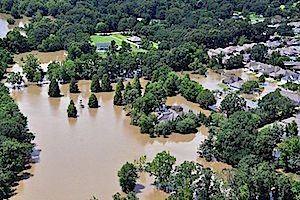Musical Performance: Eddie Palmieri

Musical Performance: Eddie Palmieri
August 19, 2016 • “An icon for modern and Latin jazz, the veteran performer continues to break tradition and innovate.” (NPR)
Photo: NPR (screen capture)


Musical Performance: Eddie Palmieri
August 19, 2016 • “An icon for modern and Latin jazz, the veteran performer continues to break tradition and innovate.” (NPR)
Photo: NPR (screen capture)

The Video Music Awards (VMAS) were held on Sunday evening. Produced by MTV, they are intended to be competitive with the Grammy’s, though focusing on pop music videos. The VMAS are known to trend towards the avant guard (think Lady Gaga wearing her notorious meat dress.) The audience enjoyed performances by Rihanna, Beyoncé, Kanye West, and Justin Timberlake, and an appearance by members of the U.S. Women’s Olympic Gymnastics Team.
Britney Spears performed on the awards show for the first time since 2007, and danced with a snake, delighting some and repelling others. And this year Rihanna won the much coveted lifetime achievement video vanguard award, but surprisingly didn’t have much air time to sing as one might expect.
Beyoncé got plenty of airtime (over 15 minutes) and won a spectacular eight awards, including the award for “Best female video.” Some critics found the show surprisingly thin on star powered performances, though Beyoncé knocked it out of the park, by all accounts, performing selections from her album Lemonade. Some go so far as to say that her passionate presentation saved an otherwise lackluster program. And building upon recent political activism, she brought four women to the awards who lost their sons to police or gun violence. This gesture has earned her praise from many, but criticism from conservatives, like former New York City Mayor Rudy Giuliani.
Some top music industry stars were noticeably absent, including Adele, who had been nominated for eight awards, and Justin Bieber. There’s some speculation that social media marketing campaigns and related promotional venues may render the awards less of a marketing necessity for top artists than in years past.
Watch the 2016 VMAS Awards (Youtube)
Photo: MTV / Wikipedia (Fair use)

An upsetting incident involving police has people angry, in Oklahoma and across the United States, as the video spreads virally. During a tense moment in the home of a suspect’s mother, police pepper-sprayed an 84-year-old woman. Many community members of Muskogee, Oklahoma are alarmed by these developments.
The woman’s son was chased back to his mother’s home, where he hid inside. The police burst in by breaking down the door, then tasered the woman’s son. But when the elderly woman refused to turn around as ordered by police, an officer pepper-sprayed her, and she fell to the floor.
The video is disturbing, and raises important questions. The mother and son are African-American, and police violence against members of the African-American community has been a major issue in the media, propelling the Black Lives Matter movement to a position of national visibility.
Would an 84-year-old white woman in similar circumstances have been treated differently? Many think so, and fear that this was an over-step of authority by the local police department, and an example of institutional racism. What if the woman had hurt herself seriously by falling to the floor? No effort was made to catch her fall, as revealed in the video tape. And elderly women are prone to osteoporosis, and a fall like that could have been debilitating and even fatal.
In addition, could a painful dose of pepper spray have serious health consequences for an elderly woman, who would be statistically more likely to suffer from respiratory and cardiovascular issues? Though the police have to react quickly on the job, did this unarmed and frightened 84-year-old woman, in a room full of police officers, represent a threat significant enough to warrant this extreme response?
The suspect was under control, and multiple officers were in the immediate presence of the small elderly woman. Frankly, it’s hard to see this incident as anything other than an over reaction by law-enforcement, at best, and a tragic example of racism at work in our communities, at worst. Fortunately this incident concluded without serious harm to the woman, or her son. It could have easily turned out differently.
Muskogee’s Chief of Police has released the tape showing the officers entering the dwelling, tasering the suspect, and ultimately pepper-spraying the old woman. The Police offers the video to the public as a sign of transparency, and seems to be willing to discuss the incident with reporters. The police are reviewing the incident. Will the police officer who pepper-sprayed the woman receive disciplinary action? Will the city make restitution to the woman for her suffering? Will the police department initiate new training procedures to minimize the chance that an incident like this won’t happen again? Time will tell, and the community of Muskogee is watching.
Watch video of police pepper-spraying elderly woman (Muskogee PD / CNN)
Photo: Muskogee PD / CNN (screen capture)

It is a terrible fact of life in our generally advanced society that innocent animals are often abused. And sadly, the internet can facilitate such crimes. It’s ironic that sometimes high tech internet technology can inadvertently help to trigger and promote some of the worst acts of barbarism. A dog was recently tortured in a terrible way, and then killed, and we know about this because the heinous offenders videotaped their crime and posted it to social media. This is, of course, an unacceptable outrage.
A petition calling for the maximum prosecution under the law for these criminals is circulating, and the internet will help that petition spread and gain traction with the public. That’s good. However, it’s frustrating to note that online social media played such a large role in triggering this event. Did the perpetrators abuse this dog because they sought internet notoriety? Did they want to go viral and make a name for themselves online? Sadly it appears this was a factor in their decision.
Of course social media companies don’t condone these kinds of crimes. But we must call on them to remain vigilant, and prevent these kinds of terrible posts, and delete them when they slip through. Social media companies control the playing field. These monsters wouldn’t have an audience for their heinous activities if not for the many social media platforms functioning online. The criminals are nothing without social media, and as any Marvel Comic fan knows, with great power comes great responsibility.
This issue isn’t reserved for high flying social media companies, either. This week the modest pages of craigslist played a role in a tragic animal abuse incident. A woman adopted a pet pig from craigslist, in Macon Georgia, but rather than shower it with love and affection, she asked her incompetent neighbor to slaughter it for food, instead. The pig endured a several hour ordeal, which included being struck with a pick axe, shot several times in non-lethal places, and beaten as well. Finally the police were called to the scene, and they decided to killed the animal in order to put it out of its misery. The police also removed dogs from the neighborhood, so animal mistreatment was rampant in the community.
We must all remain vigilant to prevent animal abuse, since these innocent creatures can’t defend themselves. In fact, they rely on us for protection. Social media and other internet venues must do their part, policing their sites for abusive posts linked to crimes against animals, and minimizing potential abuses when ever possible.
Photo: forechange.com (screen capture)

In an intellectually interesting and historically significant move, the CIA has released the secret daily intelligence briefings of President’s Nixon and Ford. The briefings, which will provide interesting fodder for both journalists and historians for years to come, are significant documents, detailing the working day to day information the Presidents received from the nation’s premier intelligence organization.
Nixon and Ford had very different styles, and backgrounds, and preferred their briefings in different formats. Nixon preferred a shorter 10 page summary while Ford preferred more detail, and his reports ran to 20 pages long. Also Nixon, the consummate ex lawyer, preferred his briefings on long legal note paper.
Both Presidents presided over difficult times for the United States, including the Vietnam War, student protest and the fallout from the civil rights era, amongst other issues. Therefore these briefings are important snapshots of what both men were learning, and discussing, during their decision making processes. One interesting revelation: the CIA told Ford that Nixon’s resignation appeared to have taken the Soviet Union and other adversaries by complete surprise.
It’s also interesting to note that Hillary Clinton and Donald Trump, the major party nominees for the U.S. Presidency, have both started receiving CIA intelligence briefings, to prepare them for the office.
Learn more about historic CIA briefings of President Nixon and Ford (CNN)
Photo: U.S. Government – Public Domain / Wikimedia Commons

There’s exciting news in astronomy. A new earth-like exoplanet named “Proxima b” has been discovered in space, and it couldn’t be any closer. It orbits our nearest neighbor in interstellar space, a small star called Proxima Centauri, only 4.2 light years away from our own solar system. It’s part of a trinary star system with two other well-known stars, Alpha Centauri A & B.
The planet is about 1.3 times larger than our own earth, and there’s a good chance it’s a rocky planet like our own. It also orbits in the so-called “goldilocks zone,” which means, like earth, it’s at the right distance from it’s star to maintain liquid water on its surface, increasing the chances that it could support life as we know it.
However, there’s a catch. Proxima Centauri is a red dwarf, which means it’s a tiny star, closer to the size of the planet jupiter than our own sun, so it generates only a small fraction of our sun’s energy, including visible light. In fact, most of the radiant energy that reaches the surface is in the infra red band, below our ability to detect visually. If plants capable of photosynthesis grew on this world, they would likely be black in color, in order to absorb all possible light under a dim red sky.
And due to the much lower energy output of Proxima Centauri, its goldilocks zone is much closer, meaning that Proxima b is so close to the star that it completes an orbit every 11 days. That contrasts sharply with the earth’s approximate 365 day orbit. And since the planet is so close to the star, it’s tidally locked, the way our own moon is as it orbits the earth.
That means that one side always faces the star, and the other side always faces away from the star, just like our moon. This creates a tremendous difference in temperature, and probably drives tremendously strong planet-wide winds (assuming the planet has an appreciable atmosphere.) Also, the planets closeness to its star means that it’s exposed to lots of x-ray radiation, which could be deleterious for life as we know it.
So the verdict’s still out on this curious earth-like world. It’s bound to be an absolutely fascinating place to visit, but is it teaming with life, like our earth? Its size, probable composition, and position within its star’s goldilocks zone are encouraging, but the tidal lock, and likely x-ray bombardment, are discouraging. And we don’t know about it’s atmosphere, and whether or not it harbors oceans of liquid water, thought to be essential for life as we know it to develop and thrive. Clearly much more study and observation is necessary over the next few decades to help answer these very important questions.
And there’s a truly exciting prospect on the horizon–the very real possibility of sending small smartphone-sized probes to Proxima b, which would take up to 30 years, in order to investigate further. A typical space voyage, utilizing traditional propulsion technology, would take over 70,000 years to reach the star system, but an innovative propulsion system based on super high powered lasers and light sails could accelerate tiny, lightweight probes to a significant fraction of the speed of light, greatly decreasing the time required for a one-way trip.
Such tiny probes could send back data, including photographs, and spectroscopic measurements, which would indicate the composition and qualities of the atmosphere, if any, and confirm the presence water, and organic compounds that are typically the bi-products of life, like oxygen and methane. And that would be very exciting.
In addition to interstellar probes, the next generation of high-powered, high-tech land and space-based telescopes could help astronomers and planetary scientists to elucidate this new and exciting mystery.
Learn more about the new exoplanet (sciencealert.com)
Photo: ESO/José Francisco (josefrancisco.org)

The management team of Face Activities extends our deepest sympathies to the families and victims of the terrible earthquake that has struck central Italy. This tragic natural disaster struck out of no where, and has resulted in considerable loss of life. We urge the international community to pull together and send aid and assistance of all kinds to Italy in this our of need.
A 6.2 magnitude earthquake has struck central Italy in the early morning hours, killing a minimum of 247 people and displacing over over 1,000. The center of the quake was 10 km south east of Norcia, and the towns of Cascia, Maltignano, Amatrice and Arquata del Tranto were also effected. Many home were demolished, and people trapped under the rubble.
Rescuers are racing against time to dig victims out of the rubble, but the remote nature of the region makes rescue difficult in many cases, and after shocks, one as powerful as 4.7, have caused serious complications. Prime Minister Matteo Renzio has addressed the nation, vowing to spare no effort during the crucial early stages of rescue, while victims are likely to still be alive.
Photo: USGS / CNN

Musical Performance: Anderson Paak & The Free Nationals
August 15, 2016 • “Watch the invigorating, genre-busting bandleader, drummer, singer and rapper perform four songs.” (NPR)
Photo: NPR

The spectacular pageantry and the ecstasy of competition concludes with dramatic closing ceremonies in Rio De Janeiro, for the the 2016 Summer Olympics. Enjoy the show!
Click here to watch the closing ceremonies of the 2016 Olympic Games in Rio
Multiple options for watching the 2016 Rio Summer Olympics:

The management team at Face Activities extends our deepest sympathies to the victims of the terrible floods in and around Baton Rouge, Louisiana, and across the state. We recognize that families there have lost loved ones, beloved pets, and property to the rising waters. This is a tremendous loss that has occurred in a state that is all too familiar with the dangers of floods.
A terrible tragedy is unfolding in the United States, far from the splendor, and petty controversies, of the Olympic games in Rio de Janeiro. Across Louisiana, following nearly three feet of heavy rains and subsequent flooding over a week-long period, over 40,000 homes are underwater, and 13 people have died. At one point the waters rose by four feet in one hour, making it very difficult for people to react effectively in this crisis. The disaster is so extensivie that nearly one third of the state’s Parishes will qualify for federal disaster relief. The extent of the damage surpasses the record-breaking flood of 1983, and brings back memories of the destruction and displacement following Hurricane Catrina.
In our modern world it’s easy to forget the awesome power of nature, and how damaging water and weather can be. The media has not helped, and has not provided adequate coverage of this devastating flood, giving priority to Olympic coverage, the Presidential election, and other events around the world. It seems extraordinary, but this catastrophic natural disaster, with such wide-ranging impact upon so many families across the region, has been relegated to second-class story status, while the drunken antics of Olympic swimmer Brian Lochte and his foolish friends take center stage, and Donald Trump’s legendary buffoonery occupies pundits and hogs air time. In fact, FEMA Administrator Craig Fugate has been highly critical of the media’s coverage during the flood, and its dreadful aftermath.
And right-wing news sources aren’t pulling any punches, shamelessly using the flood as a way to criticize President Obama, their favorite pastime, for not visiting the flood-ravaged state. In fact, Governor John Bel Edwards has defended the Obama Administration’s handling of the crisis so far. The White House, and FEMA, have been responsive and available, even with President Obama caught away from Washington, on vacation. And Governor Edwards prefers that President Obama visit in a couple of weeks, due to the resources needed to safely secure a Presidential visit.
We need a media that is responsive to real-world concerns, and sensitive to genuine tragedy and human-displacement around the world. The media has failed to cover the unfolding catastrophe in Louisiana adequately, while it appears the government is responding properly–a surprising switch from Hurricane Katrina in 2005. The American people need to be fully aware of the extent of the crisis in Louisiana, and motivated to help. That’s not likely to occur with the current state of affairs, and it will have very negative consequences for the victims of the current flood. The major media providers, including legendary franchises like The New York Times, need to take stock of their failings, and mend their ways. Charitable giving closely maps to media coverage.